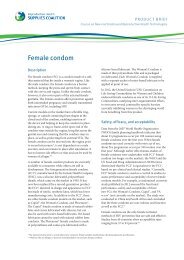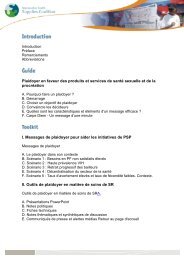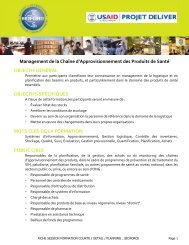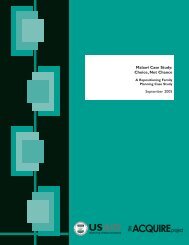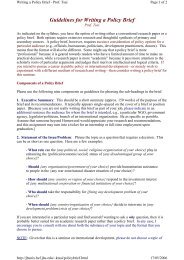EVERY WOMEN EVERY CHILD UN COMMISSION ON LIFE-âSAVING
EVERY WOMEN EVERY CHILD UN COMMISSION ON LIFE-âSAVING
EVERY WOMEN EVERY CHILD UN COMMISSION ON LIFE-âSAVING
- No tags were found...
Create successful ePaper yourself
Turn your PDF publications into a flip-book with our unique Google optimized e-Paper software.
Popularize the female condom through demonstrations and awareness building. To do this dummies and equipment for demonstration of female condom use and IEC materials will be procured and distributed. This will be supported by media awareness on female condoms and expulsion of rumors and misconceptions about the female condom. Demand creation through social marketing and condomize female condom campaign will be done. A knowledge, attitudes and practices (KAP) study will be conducted to inform this process. b) Intermediate plan • Develop, print and disseminate a national female condom implementation strategy. Build capacity for post shipment testing at national level (Procure laboratory equipment for female condom testing, Acquire technical experts on ISO certification process, build internal capacity for the NDA staff) and track shipments in to the country through the RHInterchange. • Strengthen national forecasting and quantification of female condoms and implement the alternative distribution plan. Integrate female condoms into the public sector supply chain, information in the national HMIS and develop social marketing channels, introduce a voucher system for public sector and private sector and use of mobile phones for tracking stock status at service delivery points. 3.1.2 Contraceptive Implants Problem statement Implants are an effective, safe and user-‐friendly method of family planning that has the potential to widen choices that are currently available. Widening method mix supports higher overall contraceptive uptake and continuation. Specific issues identified Provider issues: A large proportion of service providers are not trained in insertion and removal. Paramedical workers not allowed by law to insert and remove implants -‐ Revise the policy guidelines to allow trained paramedics to insert and remove implants. Provider bias and limited knowledge on how to manage side effects, poor counseling skills; Continuous bleeding leading to discontinuation of use. Formulation/ market shaping: Limited varieties and market is very small hence less incentive for the private sector Evidence/ regulatory issues: There is minimal capacity to test quality of implants and register additional suppliers for Uganda. Inadequate post testing capacity at National Drug Authority, including inability to carryout post market surveys to determine quality of implants.



